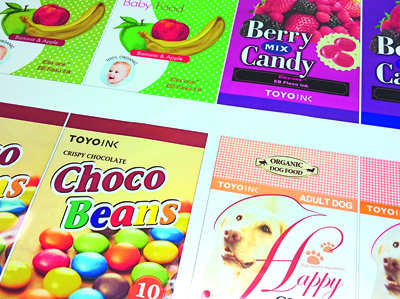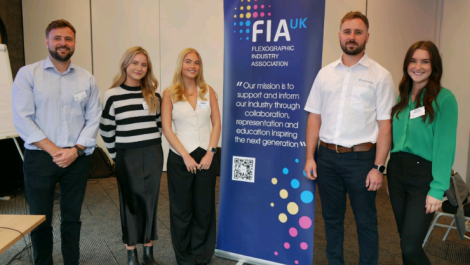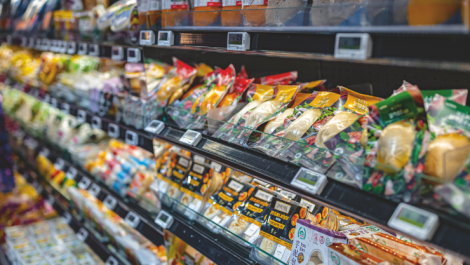The Elex-one series from Toyo Ink brings, high press stability, easy operation, lower energy and a low carbon footprint
What do you want from your inks for food packaging? Vibrant colours, scuff resistance, and a glossy finish? Electron beam inks can offer all these as well as offering low migration capabilities by using no photoinitiators at all. Michal Lodej reports.
Electron beam (EB) curing is an established technology in the web-offset sector, and has been for more than 30 years. EB curing of offset inks was first used in the USA and in Europe on paper-board, and on PE coated paper board. Today, EB drying in web-offset format is used for folding carton printing, shrink sleeve labels and also some flexible food packaging applications. Various kinds of substrates are printed wet on wet in a stack format, or on a central impression drum using six offset colour decks with a last down white, in some cases for reverse printing or an over print varnish for surface printing using a flexo coating head. All the colours and the OPV, or the white, are cured with a low voltage electron beam at 300m/min speed. This delivers good print quality in terms of low dot gain, very high print resolution, and registration. Additionally, it is time and cost effective for short runs, uses 100% solids ink and varnish systems containing no VOC’s.
So how can we see this developing in the flexo world? Well, flexo for flexible packaging is the fastest growing segment of packaging. Flexography is the dominant print technology.
Flexo, and in particular CI-Drum flexo, dominates and is seen to be increasing. Wider widths, lowest costs, higher speeds and the ability to print on various types of substrates has fuelled this growth.
Most of the CI flexo technology today uses solvent based inks. However, due to a number of market demands such as shorter run lengths, increased new design and artwork changes, shorter delivery times and sustainability concerns, EB ink is appearing as a viable alternative.
Wet wet wet
Wet on wet EB curing in flexo would meet most of the markets various requirements. Higher viscosity offered by electron cured inks would result in improved print by lower dot gain and better print resolution since it would have low to no solvents.
The question of how to trap energy cured flexo inks without interstation curing, as is required with UV inks, was puzzling polymer and ink chemists for a long time. However, there are now three offerings of wet on wet printing of energy cured inks using a CI-flexo printing presses. These three offerings are using three different principles to achieve wet on wet printing and then EB curing all the inks and OPV or laminating adhesive with one EB curing station. These principles are as follows:
1. Achieving wet on wet trapping by evaporating a non-reactive diluent, like water, from the first layer of ink, increasing the viscosity of the applied layer. Then, applying the second layer of ink at a lower viscosity onto the applied layer to achieve wet trapping.
2. Achieving wet trapping by adjusting the solubility parameter of the applied layer of ink to form a gel with a certain hardness. Laying the second layer of ink onto the gel to achieve wet trapping.
3. Achieving wet trapping by adjusting the surface tension of the second layer of ink on the applied first layer of ink.
All methods require no interstation curing or over-head tunnel drying, just one electron beam source at the end to cure the web. The inks can be applied on various substrates, are food packaging friendly, and have been demonstrated at high production speeds of 400m/min for web widths of 750 – 1700mm wide.

Sun Chemical’s WetFlex is a high solids, water-based ink that wet traps with no interstation dryers
Time to flex
Apart from the novel EB curing technology, WetFlex from Sun Chemical is a new concept in flexo printing. WetFlex is a high solids, water-based ink that wet traps with no interstation dryers. In real time the water evaporates from the printed dot, causing a rapid increase in tack and enabling the next colour dot to trap effectively. The ‘freezing’ of the dot on printing also results in almost no dot gain and a significantly higher resolution at the same screen count than solvent or water inks. As an energy cured ink, high gloss comes as standard.
The printing speed is limited only by the EB curing capacity and is for now rated at 400m/min, but tests suggest an extra 20% should be possible with full cure.
David French, Sun Chemical’s senior manager key accounts, said, ‘The inks are ready to use and can be printed as spot colours or seven-colour ECG process. In particular, printers adopting this ink from a solvent or water flexo background are delighted with the “press friendly” nature of the ink. Little or no cleaning is required because WetFlex never dries in.’
EB overprint varnishes can be trapped onto WetFlex graphics as can reverse print white. For first down white, the surface needs to be dry, so Sun Chemical has added to the range an air-dried water based white that is also EB cured at the end of the press.
The ink range is offered as generation two inks that are designed for lamination and specific surface print end uses, while generation three ink are designed for general surface print, including PE and OPP. A fully European and Swiss compliant product, migration testing of WetFlex in both lamination and surface applications has repeatedly given excellent results.
In the field
Commercially, the main pioneer of this ink set has been Al Pack of Serbia, the owner of Al Pack Uniprint in Germany. Al Pack Uniprint has printed foil lidding for dairy lids with WetFlex since 2009. Right now they are commissioning a new Uteco press in Serbia to offer the first photo-initiator free, energy cured product to that market.
On diaper back sheets, it has run trouble free for more than two years at speeds of 400m/min consistently and the customer values the avoidance of down time due to cleaning compared to his water-based flexo presses.
In Latin America, a customer replaced solvent-based inks plus lamination for pet and human food sacks with WetFlex and OPV wet on wet in-line avoiding the cost of the lamination film and a secondary process.
The product is suitable for a wide range of applications, from general purpose lamination to high resistance end uses such as outdoor sacks (with and without overprint varnish) and shrink sleeves for household cleaners.
To date, WetFlex has been used commercially on presses from three different manufacturers, but today the primary press partner is Uteco, along with ebeam Technologies for the curing unit.
Growing applications
EB technology has found a niche in applications where low odour and low migration are a must, such as food and drug packaging. Toyo Ink’s EB products continue to show strong growth in Europe for the surface printing of snack food packaging or yogurt lidding, as well as in baby diapers and other sanitary products.
Toyo Ink research labs in Japan solved the technical challenge of non-evaporative wet trapping in flexo with the development of an EB-curable ink system for CI flexo printing, the Elex-one FL series.
Elex-one brings tremendous advantages to the flexible packaging industry, such as high press stability, easy operation, lower energy, low carbon footprint and is safe for the workplace.
Since some conventional EB flexo inks contain a small percentage of volatiles (solvents and water), a small trace of such ink components may evaporate during printing. This necessitates the continuous addition of lost components to retain print quality and often leads to discrepancies in ink stability and quality during printing.
In contrast, Elex-one is a completely non-volatile ink so there is no concern for the evaporation of volatile materials. This allows for a fire-safe and VOC-free work environment and ensures stable viscosity and consistency of inks for the whole print run. This ink enables a completely solvent-free and water-free printing technique where each ink layer is applied on to the substrate without any back-trapping or mixing of inks-all this without the aid of interstation dryers. So could we see more and more EB ink used in flexible packaging? It certainly looks likely.






